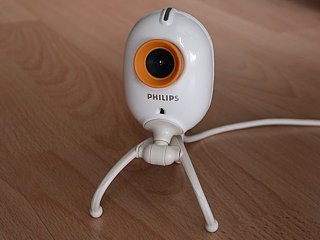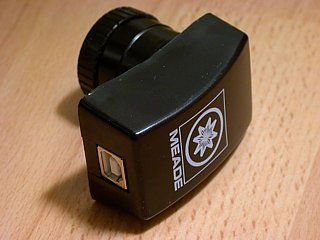Philips ToUcam Pro
versus Meade LPI
camera comparison testsRecently I had
a chance to test ToUcam Pro and Meade LPI side by side. I
think the results are quite interesting.
A, Cameras' parameters
B, Tests images
C, Conclusion
A, Cameras' parameters
| Philips ToUcam
Pro (model PCVC740K) |
Meade LPI |
 |
 |
Image
sensor:
CCD SONY
ICX098BQ (Type 1/4")
Image size: Diagonal 4.5mm, 3,87mm x 2,82mm
Effective pixels: 659(H) x 494(V) ~330K pixels
Total number of pixels: 692(H) x 504(V) ~350K
pixels
Unit cell (pixel) size: 5.6µm(H) x 5.6µm(V)
Chip size: 4.60mm(H) x 3.97mm(V)
|
Image
sensor:
CMOS Hynix Semiconductor Inc.
HV7131E1 (Type 1/3")
Image size: Diagonal 6.5mm, 5,18mm x 3,90mm
Effective pixels: 644(H) x 484(V) ~310K pixels
Total number of pixels: 648(H) x 488(V) ~320K
pixels
Unit cell (pixel) size: 8.0µm(H) x 8.0µm(V)
Chip size:
|
Exposure: 1/10000s - 0.2s (0.1ms
- 200ms)
Max. Resolution: 640x480
Compression: I420, IYUV
Maximum usable frame rate @ 640x480 resolution:
15fps (I420 compression)
Interface: USB |
Exposure: 1/1000s - 16s (1ms -
16000ms)
Max. Resolution: 640x480
Compression: RGB24 (not compressed), I420
Maximum usable frame rate @ 640x480 resolution:
3fps (not compressed)
Interface: USB |
B,
Test images
Both cameras were tested with K3CCDTools
2.2.4 (capturing and processing).
The tests were done in room (ambient temperature 23°C).
The preview of the test
images is shown in the following table in 50% size.
Click the required image to see the real, full sized, not
compressed image
(be patient, please, while they are downloading).
The tests were done in room (ambient temperature 23°C).
Prime
focus of 80mm F5 refractor
Stack of total 80seconds of captured video |
Stack of 400
x 0.2s (total 80s)

* Smaller image sensor provides smaller field of
view, but higher resolution
* The result image has a little bit higher noise
than LPI result image and also shows artifacts of
camera's internal sharpening
* The camera has apparently higher sensitivity,
but at the expsense of higher noise |
Stack of 100
x 0.8s (total 80s)

* Bigger image sensor provides bigger field of
view, but lower resolution
* The field of view of ToUcam is shown by red
rectangle
* The result image has less noise, but some hot
pixels appeared in 800ms exposure
* The camera is less sensitive - it requires 4x
longer exposure, although the field of view is
bigger
For the same field of view it would require a
barlow lens and thus even higher exposure |
Prime
focus of 80mm F5 refractor
Stack of total 80seconds of captured video
Maximum contrast (histogram stretching to show
whole range)
LPI was moved forward to object to provide the
same image size |
Stack of 400
x 0.2s (total 80s), max. contrast

* Image is a bit noiser
* Interlace artifacts
* Camera internal sharpening artifacts visible |
Stack of 80
x 1.0s (total 80s), max. contrast

* Hot pixels visible |
Detail of stack of 400
x 0.2s (total 80s), Zoom 300%
 |
Detail of stack of 80
x 1.0s (total 80s), Zoom 300%
 |
Detail of stack of 400
x 0.2s (total 80s), Zoom 300%
 |
Detail of stack of 80
x 1.0s (total 80s), Zoom 300%
 |
Prime
focus of 80mm F5 refractor
Raw frames
LPI was moved forward to object to provide the
same image size |
Raw frame 200ms

* Image is much noiser
* It also shows interlace artifacts
* Camera internal sharpening artifacts visible |
Raw frame
1000ms

* Less noise
* No apparent artifacts,
* but hotpixels are visible because of longer
exposure |
Details of raw frame 200ms (zoom 300%)

* Image is much noiser
* Interlace artifacts (see the central vertical
lines)
* Camera internal sharpening artifacts visible |
Details of raw frame 1000ms (zoom 300%)

* Less noise
* No apparent artifacts
* Hotpixels are visible |
Details of
raw frame 200ms (zoom 300%)

* Image is much noiser
* Camera internal sharpening artifacts visible (see
vertical lines)
* Green ghost artifacts in horizontal lines
(probably caused by overall frame compression and
also by I420 compression - loosy compression for
colors) |
Details of
raw frame 1000ms (zoom 300%)

* Less noise
* No apparent artifacts
* Hotpixels are visible
* Less details visible in central horizontal
lines, but it may be caused also by a little bit
worse focusing (I did my best to focus both
cameras perfectly, but in 300% zoom even small
differences are visible)
* Horizontal lines are a little bit jaggy |
C, Conclusion
It's hard to say by a few words, which camera is better.
Philips ToUcam Pro provides higher frame rate and better sensitivity,
while Meade LPI has better picture quality, but lower frame rate (maximum 3fps).
Meade LPI enables exposures up to 16s, while ToUcam Pro only 200ms.
However Philips ToUcam Pro is much more sensitive.
On oposite side - ToUcam enables shortest exposure 1/10000s,
while Meade LPI only 1/1000s.
Meade LPI is ready for use immediately after purchase,
but Philips ToUcam Pro requires to buy an adapter for telescope.
Meade LPI comes also with bundled astronomy software (sky map and capturing software).
Back to
Astrophoto page
Computer generated images,
real images, drawings and texts are property of the
author and may not be reproduced or used without
permission of author.

Last Update:
10.11.2004
|